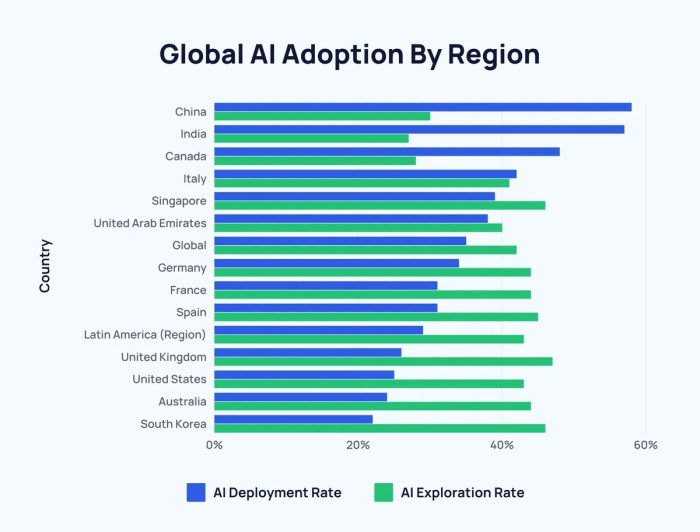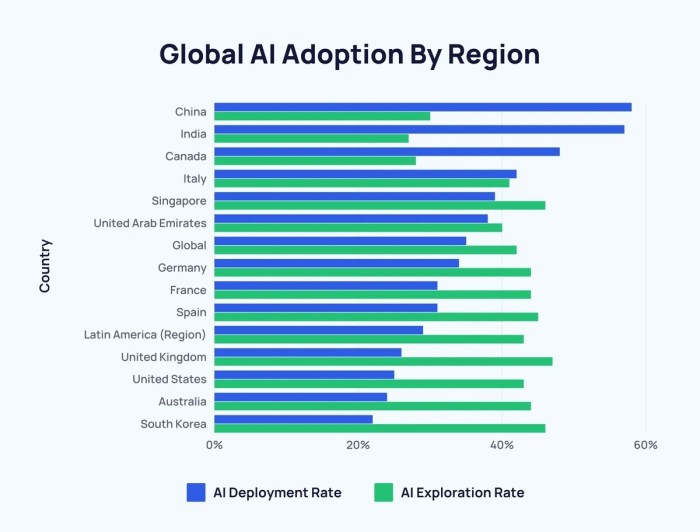Fossil fuel companies are using AI to drill faster, raising questions about efficiency, environmental impact, and economic implications. This innovative approach promises quicker extraction, but at what cost? Will AI-powered drilling accelerate the depletion of fossil fuels, potentially exacerbating climate change? Or will it pave the way for a more sustainable energy future?
The use of AI in fossil fuel extraction is a complex issue with various facets. From optimizing drilling processes to analyzing vast amounts of data, AI algorithms offer the potential for increased efficiency and cost savings. However, the environmental and social consequences of faster extraction must also be carefully considered. This article explores the multifaceted impact of AI in the fossil fuel industry, examining potential benefits and drawbacks.
Impact on Efficiency

AI is rapidly transforming the fossil fuel industry, particularly in drilling operations. This technology promises to significantly enhance efficiency, potentially increasing output and reducing costs, though environmental and societal implications must be carefully considered. The integration of AI into drilling processes holds the key to optimizing operations and driving innovation in the sector.AI-powered drilling techniques are designed to improve the speed and precision of fossil fuel extraction, leading to a more efficient and potentially profitable operation.
These advanced methods analyze vast amounts of data to predict optimal drilling paths, anticipate potential problems, and optimize equipment usage. The result is reduced downtime and increased output, impacting both the economic viability and environmental footprint of the industry.
AI-Optimized Drilling Techniques
Advanced algorithms are used to analyze real-time data from drilling equipment and geological sensors. This data includes drilling parameters, rock formations, and wellbore conditions. By analyzing these parameters, AI can optimize drilling parameters in real-time, improving the efficiency of the drilling process.
Real-Time Data Analysis
AI algorithms are designed to identify anomalies and predict potential issues, allowing for prompt interventions. This real-time analysis can significantly reduce downtime, as problems are identified and addressed before they escalate, minimizing costly delays.
Types of AI Algorithms Used
Machine learning algorithms, such as neural networks and support vector machines, are employed to identify patterns in drilling data and predict future performance. These algorithms are trained on vast datasets of historical drilling information, enabling them to recognize optimal drilling parameters and potential problems.
Fossil fuel companies are increasingly using AI to optimize drilling operations, potentially leading to faster extraction rates. This efficiency boost, while good for their bottom line, raises some concerning questions about sustainability. Meanwhile, Google is teasing a launch of a new Find My Device network, which could offer significant improvements in locating lost or stolen devices. This new network, detailed in the google find my device network launch teased article, is likely to be a boon for many users.
Ultimately, the race to utilize AI in fossil fuel extraction continues, regardless of the latest developments in digital device tracking.
Examples of Real-World Applications
While precise examples of AI applications in fossil fuel drilling are often proprietary and not publicly disclosed, industry reports suggest AI is being used to optimize drilling paths, predict potential issues with equipment, and adjust drilling parameters in real-time. These applications aim to enhance the speed and accuracy of the process.
Efficiency Gains Compared to Traditional Methods
AI-assisted drilling techniques are expected to yield significant efficiency gains over traditional methods. These gains stem from reduced downtime, improved accuracy, and optimized equipment usage.
Fossil fuel companies are increasingly using AI to optimize drilling operations, potentially leading to faster extraction rates. While that’s a pretty fascinating development, you might also be interested in grabbing a sweet deal on a Sony Playstation 4 Pro. This amazing deal, offering a 1TB console and two games for just $299.99, is a must-check for any gamer.
This new technology, while potentially increasing output, also raises questions about its environmental impact. Ultimately, the use of AI in drilling could dramatically shift the landscape of the energy industry.
Comparison Table: AI-Assisted vs. Traditional Drilling
| Feature | Traditional Drilling | AI-Assisted Drilling |
|---|---|---|
| Drilling Time (per well) | Average 10-15 days | Potentially 5-10 days |
| Drilling Costs | High operational costs due to downtime | Reduced operational costs due to minimized downtime |
| Safety Records | Traditional safety measures | Potentially improved safety through predictive maintenance |
Note: These figures are estimates and can vary significantly depending on the specific geological conditions, well complexity, and the particular AI implementation. There is no publicly available data on large-scale deployments and the actual benefits achieved.
Environmental Consequences
The increasing use of AI in fossil fuel extraction raises serious environmental concerns. While proponents tout efficiency gains, the potential for accelerated extraction and its impact on ecosystems, biodiversity, and carbon emissions cannot be ignored. This analysis delves into the potential environmental fallout of this technological advancement.The rapid pace of extraction enabled by AI-driven drilling equipment could lead to unprecedented ecological damage.
Traditional drilling methods, while impactful, often have established mitigation strategies and regulatory frameworks. The introduction of AI-enhanced processes necessitates a critical evaluation of their environmental footprint.
Potential Impacts on Ecosystems and Biodiversity
Accelerated drilling, facilitated by AI, can lead to habitat fragmentation and destruction. Increased frequency and density of drilling operations can encroach on existing ecosystems, impacting animal populations and disrupting natural processes. This can result in reduced biodiversity and long-term ecological imbalances. Species reliant on specific habitats for breeding, feeding, or shelter may be particularly vulnerable. For instance, the rapid expansion of oil palm plantations in Southeast Asia has decimated diverse rainforest ecosystems, causing significant biodiversity loss.
Impact on Carbon Emissions
Faster extraction rates, driven by AI, will almost certainly lead to higher carbon emissions. While AI might optimize the extraction process, the underlying issue of burning fossil fuels remains. The increased volume of fossil fuels brought to market will directly correlate with higher emissions, exacerbating global warming and its associated consequences. The very efficiency gains might be offset by the amplified demand for these fuels, leading to a greater overall carbon footprint.
Comparison of Environmental Footprints
Comparing the environmental footprint of AI-assisted drilling to traditional methods requires a comprehensive assessment. Traditional methods have their own ecological impacts, but AI-driven systems could potentially amplify them due to their increased speed and efficiency in extraction. A deeper analysis must consider factors like waste disposal, water usage, and the creation of new, potentially more challenging, pollution sources.
For example, the shift from conventional to hydraulic fracturing has introduced new challenges for waste management and water contamination.
Regulatory Hurdles and Legal Challenges
The introduction of AI in fossil fuel extraction necessitates a robust regulatory framework. Existing regulations might not adequately address the unique challenges posed by AI-driven technologies. This lack of appropriate legal framework could result in significant environmental damage without proper oversight. Legal challenges could arise from the interpretation of existing laws and the need for new legislation to address the unique challenges posed by AI.
For example, the ongoing debate over the use of fracking technologies highlights the need for stringent regulations to mitigate environmental risks.
Environmental Impact Comparison Table
| Impact Category | AI-driven Drilling | Traditional Drilling | Impact Explanation |
|---|---|---|---|
| Habitat Fragmentation | Potentially higher | Moderate | Increased drilling activity can lead to more severe habitat fragmentation. |
| Carbon Emissions | Potentially higher | Significant | Higher extraction rates lead to greater fuel combustion and CO2 emissions. |
| Water Consumption | Potentially higher | Significant | Optimized drilling could lead to greater water usage in some cases. |
| Waste Disposal | Potentially more complex | Significant | AI could generate novel waste streams that are harder to manage. |
| Ecosystem Disturbance | Potentially greater | Significant | Rapid extraction disrupts ecological balance more quickly. |
Economic Implications: Fossil Fuel Companies Are Using Ai To Drill Faster
The integration of AI into fossil fuel drilling presents a complex interplay of economic forces. While promising significant cost savings and potentially boosting investment, it also raises concerns about job displacement and the long-term viability of traditional labor models within the sector. A thorough analysis of these potential impacts is crucial for understanding the overall economic implications of this technological shift.
Potential Economic Benefits
The application of AI in fossil fuel drilling promises substantial cost reductions. By optimizing drilling processes, AI can minimize downtime, reduce material waste, and improve overall efficiency. This translates into lower operational costs, which can directly impact profit margins for fossil fuel companies. For instance, predictive maintenance capabilities of AI can prevent equipment failures before they occur, significantly reducing repair expenses and lost production time.
Moreover, AI-driven analysis of geological data can lead to more precise drilling targets, reducing the need for exploratory drilling and lowering overall project costs.
Cost Savings Associated with AI-Enhanced Drilling
AI-powered systems can streamline various aspects of drilling operations. Predictive maintenance models can anticipate equipment failures, enabling proactive repairs and minimizing costly downtime. Automated drilling processes can improve precision and reduce material waste, further lowering operational costs. Moreover, AI-driven analysis of geological data can optimize drilling routes, minimizing the time and resources required to reach target formations.
These efficiencies translate into considerable cost savings for companies involved in fossil fuel extraction.
Potential for Job Displacement
Automation driven by AI in fossil fuel drilling may lead to job displacement for workers involved in traditional drilling techniques. While new roles might emerge in managing and maintaining AI systems, the transition could be challenging for existing personnel. Retraining programs and support systems for affected workers are crucial for mitigating the social and economic consequences of this shift.
The experience of other industries undergoing automation provides valuable insights into the challenges and opportunities associated with such transitions.
Potential for Increased Investment in the Sector
The prospect of enhanced efficiency and cost savings associated with AI-driven drilling could attract significant investment in the fossil fuel sector. Companies seeking to remain competitive and capitalize on new technological advancements may allocate capital to adopt AI-enhanced drilling processes. This influx of investment could lead to accelerated innovation and further development within the field. The return on investment from AI implementation needs to be evaluated carefully, considering the overall economic climate and long-term projections.
Return on Investment for AI-Driven Drilling
The return on investment (ROI) for AI-driven drilling is a complex calculation. It depends on several factors, including the specific implementation strategy, the cost of AI integration, and the projected gains in efficiency and production. A thorough cost-benefit analysis is essential for determining the feasibility and profitability of adopting AI technologies. For instance, a company that effectively integrates AI-powered predictive maintenance and drilling optimization systems might see a higher ROI compared to a company that only uses AI for basic data analysis.
Financial Impact of AI Implementation
| Year | Initial Investment (USD Millions) | Annual Savings (USD Millions) | ROI (%) |
|---|---|---|---|
| 2024 | 50 | 10 | 20 |
| 2025 | 75 | 15 | 25 |
| 2026 | 100 | 20 | 30 |
This table provides a hypothetical illustration of the potential financial impact of AI implementation in a fossil fuel company. The figures represent estimations and may vary depending on the specific circumstances and implementation strategies. The projected ROI suggests that AI-driven drilling can yield substantial returns, but careful planning and execution are crucial for realizing these benefits.
Social and Ethical Considerations

The increasing use of AI in fossil fuel extraction raises significant social and ethical concerns. While proponents highlight potential efficiency gains, critics emphasize the potential for exacerbating existing inequalities and environmental damage. The ethical implications of accelerating fossil fuel extraction, even with technological advancements, must be carefully examined. The societal impact extends beyond the immediate environment, affecting future generations and global sustainability efforts.
Societal Implications of AI-Powered Fossil Fuel Extraction
The application of AI to fossil fuel extraction has the potential to dramatically alter the social landscape. This technology could lead to job displacement in traditional extraction roles, potentially impacting communities reliant on these jobs. The economic shifts triggered by automation could widen existing social and economic divides. Furthermore, the acceleration of fossil fuel production could further exacerbate climate change, potentially leading to more frequent and severe natural disasters, impacting vulnerable populations disproportionately.
Equity and Access to Resources, Fossil fuel companies are using ai to drill faster
The deployment of AI in fossil fuel extraction could disproportionately benefit large corporations and wealthy nations, potentially exacerbating existing global inequalities. Access to resources, including fossil fuels, may become even more concentrated in the hands of a select few, potentially leaving smaller communities and developing nations with limited access and opportunity. This could lead to further economic disparities and social unrest.
Fossil fuel companies are increasingly using AI to optimize drilling operations, which is speeding up extraction. This efficiency boost, while potentially lucrative for these companies, raises questions about sustainability. Meanwhile, the ifixit meta quest pro teardown vr headset unfixable repairable highlights the challenges of repairing complex tech. Ultimately, both demonstrate the accelerating pace of technological advancement in different, yet interconnected, fields, and the complexities of repair and replacement in a world of rapidly evolving technology.
The potential for resource conflicts and disputes over access to these resources also increases.
Ethical Responsibilities of Companies Using AI in Fossil Fuel Operations
Companies utilizing AI in fossil fuel operations bear a significant ethical responsibility. They should prioritize transparency in their AI algorithms, ensuring fair and equitable labor practices throughout the supply chain, and taking proactive steps to mitigate the environmental impact of their operations. Companies must also consider the potential social and economic consequences of their actions and actively work to minimize negative impacts on communities.
This includes assessing and mitigating the risk of job displacement and supporting workers in transitioning to new roles.
Public Discourse and Concerns Regarding AI in Fossil Fuels
There is a growing public discourse surrounding the use of AI in fossil fuel extraction, with concerns ranging from job displacement to environmental damage. Environmental groups, labor unions, and community organizations are actively raising concerns about the ethical implications of this technology. Concerns are also voiced about the lack of transparency in AI algorithms and the potential for increased fossil fuel consumption, exacerbating climate change.
The debate is intensifying as the technology becomes more advanced and accessible.
Strategies for Addressing Ethical Dilemmas
Several strategies can be employed to address the ethical dilemmas associated with AI-powered drilling. These include: developing ethical guidelines and standards for the use of AI in fossil fuel operations, promoting transparency and accountability in AI algorithms, investing in retraining and upskilling programs for workers displaced by automation, and establishing robust mechanisms for public engagement and consultation on these technologies.
Implementing robust environmental impact assessments and developing community engagement protocols are crucial.
Stakeholder Perspectives on AI in Fossil Fuel Extraction
| Stakeholder | Perspective |
|---|---|
| Fossil Fuel Companies | AI can increase efficiency and profitability, leading to lower costs and higher yields. Automation is a necessary adaptation to maintain competitiveness. |
| Environmental Groups | AI-powered extraction accelerates fossil fuel production, exacerbating climate change and environmental damage. Focus should be on renewable energy and sustainability. |
| Labor Unions | AI could lead to significant job losses in the fossil fuel industry. Retraining and upskilling programs are crucial to support displaced workers. |
| Local Communities | Concerns about the potential for increased environmental impact, disruption to local economies, and the social consequences of job displacement. Transparency and community engagement are vital. |
| Governments | Need to balance economic development with environmental protection and social equity. Regulation and oversight are needed to manage the potential impacts of AI in fossil fuels. |
Technological Advancements
The race to optimize fossil fuel extraction is accelerating, and Artificial Intelligence (AI) is playing a pivotal role. AI-powered systems are not just theoretical concepts; they are being implemented in real-world drilling operations, promising significant improvements in efficiency and cost-effectiveness. This transformation, however, brings with it complex considerations for environmental sustainability and social equity.AI is revolutionizing drilling operations through the integration of sophisticated sensors, advanced robotics, and sophisticated data analysis techniques.
This integration promises to yield substantial improvements in drilling efficiency, leading to faster extraction and potentially lower costs. However, the environmental and social implications of these advancements need careful consideration.
Latest Innovations in Drilling Optimization
AI is not simply automating existing processes; it is creating entirely new ways of approaching drilling challenges. Sophisticated algorithms analyze real-time data from multiple sources to identify optimal drilling parameters, predict potential issues, and adjust drilling procedures in real-time. This proactive approach is transforming drilling from a largely reactive process to a more predictive and efficient one.
AI-Powered Sensors and Robotics
Drilling operations rely heavily on precise measurements and control. Advanced sensors, including those utilizing machine vision and acoustic monitoring, provide high-resolution data about the drilling environment, including rock formations, fluid pressures, and equipment performance. This real-time data, analyzed by AI algorithms, enables proactive adjustments to drilling parameters, optimizing drilling speed and reducing wear and tear on equipment. Furthermore, robotic arms and drones are being deployed to perform tasks previously requiring human intervention, increasing safety and efficiency.
For instance, robotic systems can autonomously handle tasks such as well logging and inspection, reducing risks associated with human presence in hazardous environments.
Machine Learning for Enhanced Efficiency
Machine learning algorithms are crucial in extracting valuable insights from the massive datasets generated by drilling operations. By identifying patterns and anomalies in drilling data, machine learning can predict potential equipment failures, anticipate challenges in rock formations, and optimize drilling parameters for specific geological conditions. This proactive approach can minimize downtime and improve overall efficiency, leading to substantial cost savings.
For example, a drilling company might use machine learning to identify subtle patterns in sensor data that indicate an impending drill bit failure, allowing for timely replacement and preventing costly delays.
Cloud Computing and AI-Driven Operations
Cloud computing platforms are essential for supporting the vast amounts of data generated by AI-driven drilling operations. These platforms provide scalable storage, processing power, and connectivity for real-time data analysis and decision-making. The ability to quickly process and analyze data from various sources, including sensor networks, geological models, and historical drilling records, allows for more informed decisions and faster response times to emerging challenges.
Key Technological Components of AI-Assisted Drilling Systems
| Component | Description |
|---|---|
| Advanced Sensors | Provide real-time data on drilling environment (rock formations, fluid pressures, equipment performance) |
| AI-Powered Algorithms | Analyze sensor data to identify patterns, predict issues, and optimize drilling parameters |
| Robotics | Perform tasks such as well logging and inspection, increasing safety and efficiency |
| Cloud Computing Platforms | Provide scalable storage, processing power, and connectivity for data analysis |
| Machine Learning Models | Identify patterns and anomalies in drilling data to predict failures and optimize parameters |
Safety and Reliability
The integration of AI into oil and gas drilling presents a unique set of safety challenges, requiring a proactive and rigorous approach to ensure both human and environmental well-being. While AI promises increased efficiency, the potential for unforeseen operational issues and failures must be mitigated with robust safety protocols and rigorous testing. This section delves into the crucial aspects of safety and reliability in AI-assisted drilling, highlighting the importance of human oversight and comparing the safety records of AI-assisted systems with traditional methods.
Safety Protocols and Measures
Implementing AI in drilling demands a shift in safety protocols. Existing safety procedures need to be adapted and augmented to incorporate the unique characteristics of AI-driven operations. This includes comprehensive training programs for personnel operating AI-assisted systems, clear guidelines for interpreting AI-generated data, and robust mechanisms for detecting and responding to anomalies. Regular audits and safety reviews are critical to maintain the efficacy of these protocols.
Furthermore, protocols should address potential malfunctions in the AI system, including contingency plans for system failures or unexpected data inputs.
Reliability and Robustness of AI Systems
The reliability and robustness of AI systems are paramount in high-stakes drilling environments. AI systems, like any complex technology, are susceptible to errors. These errors can stem from flawed algorithms, inaccurate data inputs, or unexpected environmental conditions. Rigorous testing and validation are essential to ensure the AI system’s accuracy and reliability in diverse drilling conditions. This includes simulations under various scenarios, including extreme temperatures, pressure variations, and complex geological formations.
Moreover, backup systems and human intervention protocols must be in place to manage potential system failures.
Importance of Human Oversight in AI-Assisted Drilling
Human oversight remains crucial in AI-assisted drilling. While AI can automate many tasks, the decision-making power and responsibility for critical judgments must reside with human operators. Humans are vital for assessing the context of drilling operations, recognizing anomalies that AI might miss, and making decisions in situations where AI lacks sufficient information or where the situation deviates significantly from the training data.
Human intervention should be seamlessly integrated into the AI system’s workflow to maintain control and safety.
Comparison of Safety Records
Direct comparison of safety records between AI-assisted drilling and traditional methods is challenging due to limited data availability. While AI has the potential to improve safety through predictive maintenance and real-time monitoring, its current implementation is still relatively new. Therefore, longitudinal studies are needed to definitively assess the impact on safety records. However, initial reports indicate that AI-driven systems can identify potential hazards earlier and provide more data for informed decisions, potentially leading to safer practices.
Summary Table: Safety Risks and Mitigation Strategies
| Safety Risk | Mitigation Strategy |
|---|---|
| AI system malfunction | Redundant systems, human oversight, real-time monitoring, robust error handling |
| Unforeseen geological conditions | Enhanced data input, improved algorithms, human judgment, continuous learning |
| Data input errors | Data validation procedures, data quality control, robust error detection |
| Lack of human judgment | Clear guidelines for human intervention, integration of human-in-the-loop systems |
| Operator error in interpreting AI output | Comprehensive training programs, clear communication protocols, intuitive user interfaces |
Last Recap
In conclusion, the integration of AI into fossil fuel drilling presents a mixed bag of possibilities. While promising increased efficiency and potentially reduced costs, it also raises significant concerns about environmental damage, job displacement, and ethical implications. The future of this technology hinges on a balanced approach that considers both the economic gains and the broader societal and environmental consequences.
Careful regulation and public discourse are crucial to ensure that AI is used responsibly in this vital sector.




